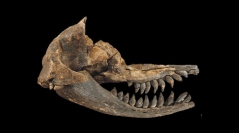

 Comptes Rendus Palevol
7 (6) - Pages 361-369
Comptes Rendus Palevol
7 (6) - Pages 361-369A finely preserved skull with mandible and teeth associated, from the Latest Miocene beds (ca. 6 Ma) of the Pisco Formation, Sud-Sacaco, Peru, represents a new physeteroid genus and species, Acrophyseter deinodon. This moderate size sperm whale is characterized, among others, by: the short rostrum, the mandible distinctly curved upwards, large teeth very close together (12 on each upper tooth row and 13 on each lower tooth row), the lateral margin of the maxilla along the rostrum base much lower than the orbit roof, a wide supracranial basin dorsally overhanging the right orbit and limited to the cranium and a large temporal fossa dorsomedially elevated. A preliminary cladistic analysis provides a phylogenetic position of Acrophyseter nested within the stem-Physeteroidea, more basal than the clade Kogiidae + Physeteridae. The morphology of the oral apparatus and of the temporal fossa suggests that Acrophyseter was able to feed on large preys.
Odontoceti, Physeteroidea, Sperm whale, Latest Miocene, Peru